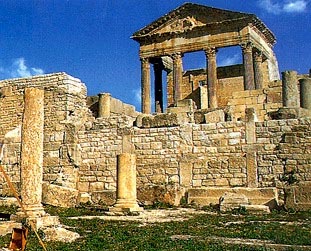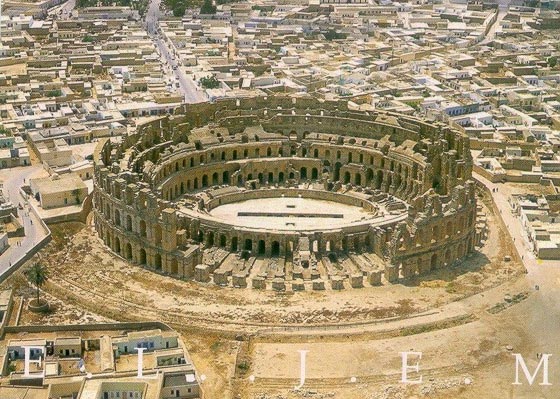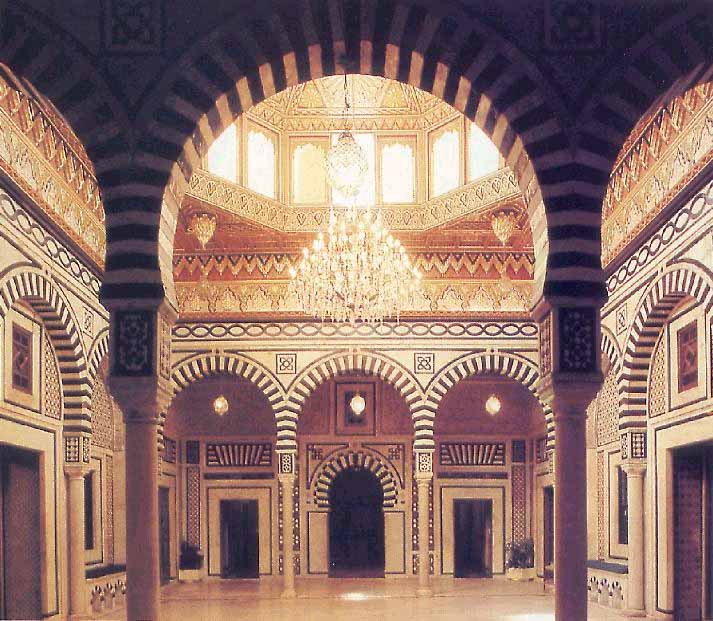814 BC: Foundation of Carthage by Phoenician settlers led by Queen Dido.
264 BC to 146 BC: The Punic Wars: Three wars with Rome, including elephant-mounted expedition by Hannibal across the Alps (218-202 BC,) end with the defeat of Carthage.
146 BC-439: Establishment of the first Roman Colony, Africa, and its attachment to the Roman Empire.
439: Takeover of Carthage by the Vandals.
533: Takeover of Carthage by the Byzantines.
647-698: Advent of the Arab-Islamic period. Foundation of Kairouan by Oqba lbn Nafaa (670), and takeover of Carthage by the Arabs (698).
800-909: Expansion of Islam and establishment of the Aghlabid Dynasty. (Construction of the Zitouna Mosque in Tunis).
909-1159: Fatimid and Zirides dynasties. Foundation of Mahdia (921).
1159-1230: Almohads unify the Maghreb countries and Moslem Andalusia.
1230-1574: The Hafsids break away from Almohads and establish new dynasty based in Tunis.
1574: Tunisia becomes part of the Ottoman Empire.
1705-1881: Husseinite Dynasty.
1881-1956: French Protectorate (established 12 May 1881). Anti-colonial resistance, led mostly by the Neo-Destour party, persisted for most of the 75 years of French domination.
1956 (20 March): Independence from France.
1957 (25 July): Proclamation of the Republic. Habib Bourguiba becomes first President of Independent Tunisia.
1959 (1st June): Adoption of the first Constitution of the Republic of Tunisia.
1963 (15 October): The French evacuate Bizerta, their last base in the country.
1987 (7 November): In conformity with the Constitution, Prime Minister Zine El Abidine Ben Ali succeeds President Bourguiba who is declared by his physicians unable to continue assuming the duties of the Office. President Ben Ali is sworn-in by Parliament.
1989 (2 April): Presidential and legislative elections. Zine El Abidine Ben Ali elected President.
1994 (20 March): Presidential and legislative elections. Re-election of President Ben Ali and accession of the opposition to Parliament, for the first time in the history of independent Tunisia.
1999(24 October): After first-ever contested presidential elections, President Ben Ali is re-elected by an overwhelming majority for a third term. the Democratic Constitutional Rally keeps its majority in the Chamber of Deputies but the opposition garners 20% of the 182 seats.
The number of women in Parliament also increases to 21.
CARTHAGE
Tunisians traded and interacted with other Mediterranean cultures since
the 12th century BC. Ancient Carthage, the great city-state founded in
814 BC, so prospered in trade and commerce that it attracted the eyes
of an expanding Roman Empire. The fall of Carthage in the second century
BC ushered in nearly 700 years of Roman rule. Tunisia prospered as the
granary of the Roman Empire. The many splendid archaeological sites which
dot the Tunisian landscape today attest to Tunisia's prominent position
in the empire.
ARAB MOSLEM ERA
In the fifth and the sixth centuries AD, Roman influence was replaced
by that of, first, the Vandals and later the Byzantines. In the seventh
century AD, Islamic conquest reached Tunisia. The city of Kairouan became
the center of religious life and the site of one of Islam's most ancient
and holiest mosques. In the ensuing centuries, Islamic civilization enriched
Tunisia during five long dynasties both Arab and Ottoman. High points
during this period were the establishment in Tunis of the Great Mosque
and Islamic University of Zitouna; the flourishing of great thinkers such
as Ibn Khaldoun, historian and father of modern sociology, who produced
works which still influence scholarship ; and the arrival of Muslim Andalusian
immigrants expelled from Spain in 1492. By the 16th century, Tunisia was
under Ottoman control, and a dynasty of Beys governed the country.
FRENCH PROTECTORATE
In the 19th century, Tunisia was the first Arab country to promulgate
a Constitution and ban slavery, but economic problems, abuses by the Beys
and foreign interference were the source of increased instability. In
1881, France declared Tunisia a Protectorate, generating a strong anti-colonial
reaction in the country.
INDEPENDENCE
In 1920, the Liberal Constitutional Party (the Destour) was formed by
Tunisian nationalists. The breakaway new Destour, created in 1934, eventually
became the driving force behind Tunisian independence. After a long struggle,
Tunisia finally won its independence on March 20, 1956.
MODERN HISTORY
On July 25th, 1957, Habib Bourguiba, the first President
of Tunisia, declared the new nation a Republic. On June 1, 1959, the first
Constitution of the Republic was adopted.
On November 7, 1987, Zine El Abidine Ben Ali, who at the time was Prime
Minister and the constitutionally ordained successor, became the Republic's
second President, after President Bourguiba became unable, for health
reasons, to continue assuming the duties of the office. Tunisia's first
succession was smooth and peaceful.



